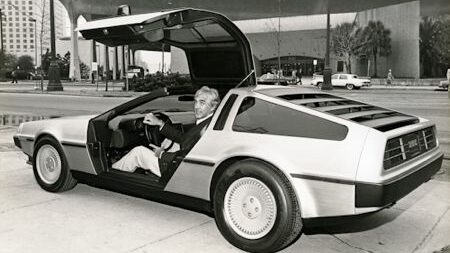During the three decades that the Western Group of Motoring Writers has been in existence, huge numbers of new vehicles have been launched, and in that time the cars – and the technologies built into them – have evolved in dramatic fashion.
With the working title to our new series being ‘Back to the Future Classics’, and with these features being rolled out on our website throughout 2013, I am highlighting a selection of models introduced since the early 1980s.The cars I’ve chosen reflect some of the design changes that have taken place across the motor industry during this time, and I shall be bringing to your computer “12 of the most significant future classics launched in the last 30 years”. At least, that’s my story, and I am sticking to it.
As my list of vehicles bears a particularly evocative title, I feel it would not be complete without including one of the most memorable models ever produced, and which was launched at around the same time that the Western Group was being hatched. It is, of course, the original ‘Back to the Future’ car, the DeLorean DMC-12…
Whether you are a fan of the model or not, the ‘dare to be different’ DeLorean DMC-12 made news from the moment it was conceived.
Production started in February 1981 at a purpose-built factory at Dunmurry, Belfast, at the instigation of John DeLorean.
Ever since then, the model has captured the imagination of enthusiasts, not least of course due to its starring role in the ‘Back to the Future’ blockbuster films.
The appearance of the car has always been striking, with the angular bodywork made of non-corroding stainless steel, and featuring a ‘brushed’ finish. Two high-lifting ‘gull wing’ doors open to reveal an interior which is still regarded as luxurious, and which was indeed futuristic for the early 1980s.

However, hiding beneath the bold exterior – styled by Ital Design (Giugiaro) – is a mixture of proprietary running gear components from other manufacturers. The Lotus Esprit chassis was used as the basis for that of the DeLorean, and Lotus suspension was employed too. The 2.8 litre V6 engine (overhead valve, pushrod unit) and the transmission (five speed manual or three speed automatic) came from the Peugeot/Renault/Volvo set-up.
In fact the only components actually made at Dunmurry were the glass fibre underbody assemblies. However, the fact that most parts were sourced from other makers was always helpful when it came to obtaining spares, and this aspect is even more important for enthusiastic owners today.
With a fairly modest 130 bhp developed by the rear-mounted V6 motor (upped to 160 bhp for UK versions), typically it will take a healthy DeLorean around eight seconds to hit the 60 mph mark, from a standing start. However, acceleration is only part of the story, for these cars are especially adept at long-distance high speed cruising. Where speed limits allow, cruising for hours at 90 mph in fifth (top) gear sees the tachometer needle indicating just 3,500 rpm. For the record, the top speed is 130 mph.
The spacious interior features two comfortable, well-padded leather-trimmed seats and comprehensive instrumentation.
Standard equipment includes central locking, electrically operated windows, air conditioning, a tilt/adjustable steering wheel and a quad speaker stereo system, among other goodies. Handling/roadholding qualities are predictable and ‘fun’, the ride quality is accommodating, and traction excellent (with the weight of the engine and transmission bearing down on the driven rear wheels).
Fuel consumption varies between 21 and 30 mpg, approximately, depending on use. A total of 8,583 DeLoreans were built, most finding buyers in the United States, where the first 500 examples produced were destined.
Approximately 25 right hand drive examples were produced, ‘on request’. Due to political and financial complications which overshadowed the ingenuity of the car’s design, by the summer of 1982 the main production story was all-but over, although 100 additional ‘1983’ examples were built in the U.S.A.DeLorean owners love their cars, and find the vehicles easy and inexpensive to own.Interest in the surviving examples is increasing all the time. It is a fact that ever since around 1990, the prices of these individualistic, fascinating and eye-catching classics have been rising. So, if you fancy one, it would be best to buy it sooner rather than later. If you do take the plunge, attention is guaranteed, wherever you take the car.Back to the future? Well, from the outset this car was destined to be an iconic classic of its time. At least, that’s a prediction I made in 1981 and so far it seems to be on course…
© Kim Henson Images sourced thanks to Virtual Motorpix

